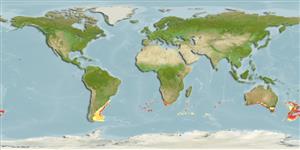Common names from other countries
>
Syngnathiformes (Pipefishes and seahorses) >
Centriscidae (Snipefishes and shrimpfishes) > Macroramphosinae
Etymology: Centriscops: Greek, kentris, -idos = sting + Greek, ops = appearance (Ref. 45335); humerosus: Centriscops is the Greek word for bellows and eye (meaning a bellowsfish with a large eye) and humerosus for shoulders (referring to the large bony plates on the upper flanks) (Ref. 57469).
More on author: Richardson.
Environment: milieu / climate zone / depth range / distribution range
Sinh thái học
Biển Tầng đáy biển sâu; Mức độ sâu 35 - 1000 m (Ref. 9563), usually 400 - 750 m (Ref. 9563). Deep-water; 30°S - 56°S, 69°W - 175°W (Ref. 57469)
Circumglobal in southern temperate waters. Southeast Atlantic: South Africa, from Cape Columbine to False Bay; also reported from Tristan da Cunha and Gough Island (Ref. 11228). Southwest Atlantic: Argentina. Southwest Pacific: Australia and New Zealand (Ref. 5755).
Bộ gần gũi / Khối lượng (Trọng lượng) / Age
Maturity: Lm ? range ? - ? cm
Max length : 30.0 cm SL con đực/không giới tính; (Ref. 57469)
Các tia vây lưng cứng (tổng cộng) : 7; Các vây lưng mềm (tổng cộng) : 16 - 18; Tia cứng vây hậu môn: 0; Tia mềm vây hậu môn: 17 - 21. Orange in color with 6 oblique dark red to blue bands (Ref. 5382). Four well-developed plates on body in a line behind eye (Ref. 57469).
Occur on the continental shelf and slope (Ref. 9563; 7300). Feed on benthic invertebrates (Ref. 11228).
Life cycle and mating behavior
Maturities | Sự tái sinh sản | Spawnings | Egg(s) | Fecundities | Ấu trùng
May, J.L. and J.G.H. Maxwell, 1986. Trawl fish from temperate waters of Australia. CSIRO Division of Fisheries Research, Tasmania. 492 p. (Ref. 9563)
IUCN Red List Status (Ref. 130435)
CITES (Ref. 128078)
Not Evaluated
Threat to humans
Harmless
Human uses
Các nghề cá: Tính thương mại
Các công cụ
Special reports
Download XML
Các nguồn internet
Estimates based on models
Preferred temperature (Ref.
115969): 4.6 - 9.7, mean 7.3 (based on 245 cells).
Phylogenetic diversity index (Ref.
82804): PD
50 = 1.0002 [Uniqueness, from 0.5 = low to 2.0 = high].
Bayesian length-weight: a=0.01479 (0.00600 - 0.03648), b=2.93 (2.72 - 3.14), in cm Total Length, based on LWR estimates for this (Sub)family-body shape (Ref.
93245).
Mức dinh dưỡng (Ref.
69278): 3.6 ±0.53 se; based on food items.
Thích nghi nhanh (Ref.
120179): Trung bình, thời gian nhân đôi của chủng quần tối thiểu là 1.4 - 4.4 năm (Preliminary K or Fecundity.).
Fishing Vulnerability (Ref.
59153): Low to moderate vulnerability (27 of 100).
Climate Vulnerability (Ref.
125649): High vulnerability (58 of 100).
